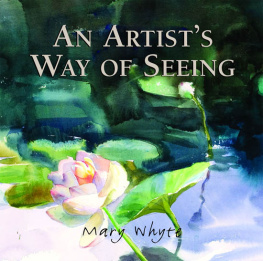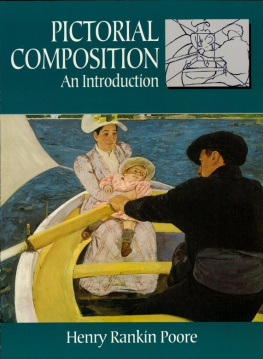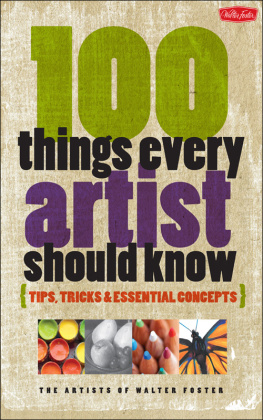All rights reserved. No part of this book may be reproduced by any means whatsoever without written permission from the publisher, except brief portions quoted for purpose of review.
Acknowledgments
This book would not have come together without the enthusiasm and effective collaboration of my editors at Wyrick & Company, the writing expertise of Jane OBoyle, and the artistic eye of Sally Heineman.
Special thanks to Becca Ansert and Croft Lane for their dedication and patient assistance, and to friends Connie McGeorge, Sarah Myles and Carol Barnes for their encouragement and comments.
My deepest love and gratitude go to my husband, Smith Coleman, who will forever be one of Gods greatest blessings in my life.
Finally, I wish to thank the many students I have had the good fortune to have known over the years. You have taught me some of my most valuable lessons about painting and life.
Introduction
There are moments in our lives, there are moments in a day, when we seem to see beyond the usual. Such are the moments of our greatest happiness.
Robert Henri, The Art Spirit
I dont believe any artist has ever truly been able to explain why we paint. Many have tried. I think artists paint simply because it feels good, like sun on the back of the neck. Making art fills us with a surprising and unexpected happiness, the same as when we hear tree frogs singing on the first warm night of spring. For artists, our work nourishes us and fills our senses. Every aspect of creating a painting is pleasurable: the feel of the brush in your hand, the smell of paint, the sound of a pencil moving across paper. Mixing color on the palette is like watching butterflies come to life.
I once heard someone say that artists spend their entire lives painting what really amounts to nothing more than a series of self portraits. I think, in some respects, this may be true. Although we may be able to control and improve the quality of our work, the substance of what we ultimately express was embedded in our genes long ago. The sooner we come to realize and embrace this notion, the more original and engaging our creations will be.

SUMMER SOLSTICE
Whether we are artists or not, we all seek a life that is filled with moremore creative pauses, more colorful relationships, more meaning. Everyone wants the secret to success and happiness. In my classes, I show students that they have to identify what they are feeling in order to paint, that the quality of their production is not primarily about technique or copying. As artists, we paint from our hearts as well as our heads.
Still, students keep asking me for tips, as if they were recipes. They want to know the exact mixture of blue and white in order to duplicate the summer sky or the veil of a shadow on a white lace cuff. When I tell them what I used in a particular place they take copious notes. A little bit of cerulean blue here, a dab of ultramarine, a tempering of burnt sienna there. I tell them that they are writing down the wrong things. Painting is not just about matching a tube of paint to the object. They should be recording what the summer sky feels like, how it arches over us like a magnificent Chinese porcelain bowl, the figures of flying birds painted against its curved sides. Or with a cuff of lace, what really matters is how it momentarily gathers and falls around the sitters delicate pale wrist, its lithe stillness matching hers. And that, in a moment, the sitter and her lace cuff will rise from the chair and, like a fleeting cloud, disappear.
Truly learning to paint then becomes, in large part, a matter of learning how to see. This means we must become masters at observing and feeling the world around us before we can begin to express it on an easel. It also becomes a matter of knowing ourselves.
Each of us is given the same set of colors with which to compose our lives. We choose and mix the colors we love the most, keeping some, wiping away others, perhaps returning to the same few over and over again. With time, our creations become less like those of anothers. Gradually, we start to recognize what it is we are trying express and, one day, discover that what we have is a life that is extraordinarily unique. The colors are more pure, more like us, and as astonishing as the blue of the summer sky. This discovery brings enormous satisfaction.
Even with this self-discovery, not every day in the studio flows so easily. Many days I want to heave everything out the window. Making a painting is in many ways similar to navigating a life. The study, dedication, and tenacity required for both painting and life do not always guarantee that we get what we want. We keep at it, do our best, and, hopefully, learn something along the way. If we are really fortunate, we leave behind something that matters.
Everything that we paint is in some way who we are. Like many artists, I have found that certain themes continually creep into my work. Certain colors, too, keep finding their way into the crevices, like dust between the floorboards. To me, specific colors reflect different stages of my life and signal memories that bring me back to lessons I have learned and people I have known. These memories, these colors of the rainbow, are how I live and paint, and the guidelines by which I now teach. All of these colors, in spots and splashes and wavy lines, have given me a lifetime of pleasure.

STREET SWEEPER, NEW ORLEANS
Caf du Monde in New Orleans is a favorite of mine for early morning hot chocolate and beignets. Its even handier when one can set up an easel near the cafe and return frequently for refills. On this morning, it had just rained, making interesting reflections in the puddles. The shape of the street sweeper moving back and forth was irresistible, and when my model noticed that I was painting him, he swept more slowly and lingered in the area until I was finished.

SKETCHBOOK JOTTINGS
Small, quick sketches like this capture the essence of a figure in motion. These visual snapshots can be helpful when developing a painting.
When I was in first grade, and home from school because of a cold, my father presented me with a big new box of crayons. I sat on the floor next to a black and white Lucy on the television, and was mesmerized by the way the crayons were tiered up in the box like tiny choral singers on a stage. Each colorful crayon was a jewel in my hand, its waxy smell and small descriptive name on the wrapper giving me a heady feeling. I carefully tested each color on the paper my parents had given me, and immediately fell into rapture over the crayon marked chartreuse. I remember my absolute delight as I took that one crayon and drew with it the rest of the day, until I had worn it down to a pea-sized nub. The discovery of chartreuse was sheer happiness. Now, when I see the color on designer handbags or a sofa pillow, I smile, knowing I wouldnt trade one minute of my life for the feeling of holding that crayon in my hand.









